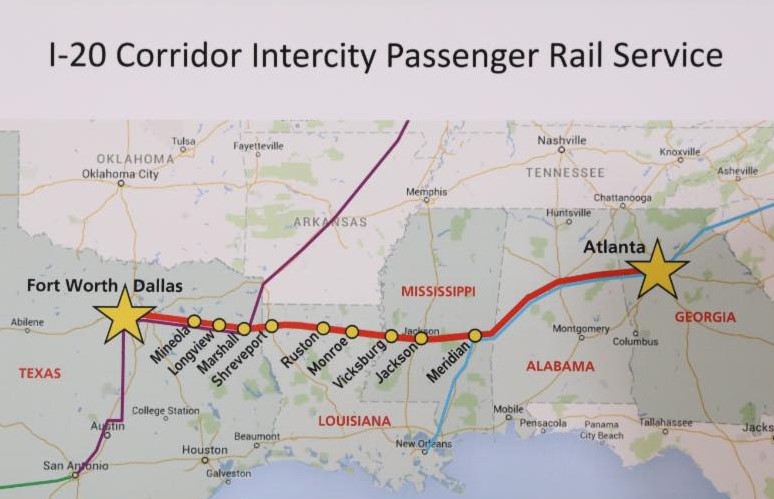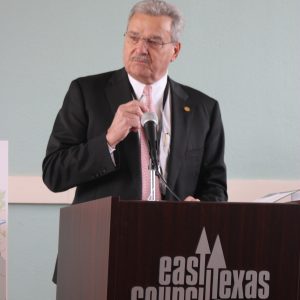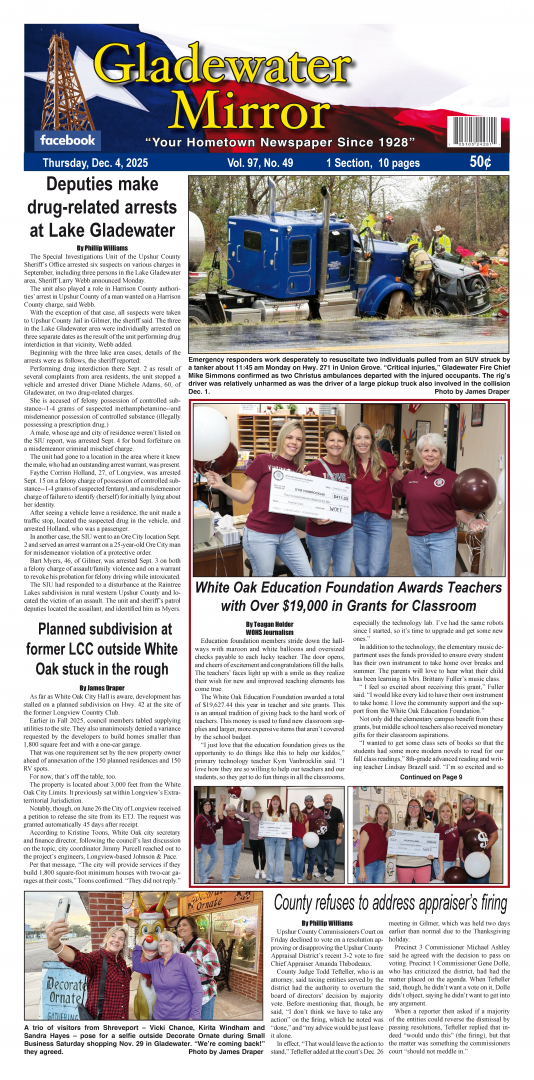 In a few years, an East Texan will be able to hop on passenger rail here and go West to DFW and beyond to the coast, East to Meridian, Mississippi, and beyond to Atlanta, Georgia.
In a few years, an East Texan will be able to hop on passenger rail here and go West to DFW and beyond to the coast, East to Meridian, Mississippi, and beyond to Atlanta, Georgia.
It’s been a long time coming – almost 20 years of negotiations, advocacy and some arm twisting – but a coalition of East Texas elected officials on Tuesday announced the I-20 Corridor Intercity Passenger Rail Service is on the federal drawing board.
“It’s extremely important. They’ve looked at all kinds of different wants to go around us, but they’ve decided this is the way to go,” Gregg County Judge Bill Stoudt told local, regional, state and federal representatives gathered alongside members of the media in Longview’s Depot/Multi-Modal Transportation Center Dec. 19. “This marks a significant milestone for the long-advocated rail connection between Dallas-Fort Worth and Atlanta, Georgia.”
The Federal Railroad Administration designated the stretch in its FY22 Corridor Identification and Development Program.
 Part of a broader effort to connect the United States’ East Coast with the West via passenger rail, the regional route passes through Mineola, Longview, Marshall and into Northern Louisiana, a single path between DFW and Meridian.
Part of a broader effort to connect the United States’ East Coast with the West via passenger rail, the regional route passes through Mineola, Longview, Marshall and into Northern Louisiana, a single path between DFW and Meridian.
“The east-west connection across our southern region will bring significant benefits to both urban and rural areas,” Stoudt said. “This is going to be a game-changer for East Texas in the years ahead. All citizens who call East Texas home will benefit from this.
“It’s economic development, going forward.”
Marion County Judge Leward LaFleur is chairman of the East Texas Rural Transportation Planning Organization, affiliated with East Texas Council of Governments.
“This is an early Christmas gift for our region,” LaFleur said last week. “The other routes that were looked at just weren’t doable. They would cost a significant amount of money.
“East Texas is the perfect route for this project, allowing the development of new services to align on existing infrastructure.”
A joint application to the Federal Railroad Administration submitted by the Southern Rail Commission secured a $500,000 grant – with no matching funds component – to complete Step 1 of the project. That includes further development of the scope of the effort, a schedule and cost estimates.
Right now, there’s no timetable, said Harrison County Judge Richard Anderson, a standout advocate for the intercity passenger rail effort alongside his wife, Christina.
“This is a transportation alternative. This is an economic development issue,” Anderson said. “A half-a-million is a lot of money, but in the greater scheme it is not.
“The most important aspect of this is it puts us in line with the Federal Railroad Administration designation to receive money” for Step 2, completion of the service development plan, and Step 3, actual implementation of the project.
 It’s incremental, he said, echoing LaFleur, and each step must be completed in turn over time.
It’s incremental, he said, echoing LaFleur, and each step must be completed in turn over time.
“This gets our name in the hat, it gets us in the line in order to be able to access this. That’s a generational investment.”
For 17 years, a coalition of county judges, mayors, elected officials and grassroots advocates have fueled the project which, upon completion, would see passenger trains operating at 79 to 125 miles per hour between the connected cities.
“Instead of fighting the horrific traffic in DFW and I20 in spots between here and there,” LaFleur said, “you can jump on a rail car in Marshall, Texas, and be in downtown Dallas in an hour and 20 minutes, get in an Uber and go wherever you want and be back that day.
“It’s a bar none great thing.”
A feasibility study for the concept was completed with Amtrak in the past, LaFleur noted, giving the latest push a jump start. Stoudt thanked Amtrak for years of partnership with East Texas’ communities.
“We look forward to the continued collaborative efforts going forward.”
Not everybody can afford to fly in an airplane, he added later. Not everyone can afford the upkeep on a car.
“A train is much more adaptable to the lifestyle they have.”
According to Stoudt, there are no land acquisitions anticipated, with plenty of right-of-way along the existing rail route, much of which is already double-tracked.
Cost estimates are still in the ether, and implementation could be a 10 years off, 15 or more.
The important thing: “They have formalized the route,” Stoudt said, straight through East Texas. “Up until two days after Thanksgiving, there were other areas they were looking at and other routes possibly going north of here.
It’s a big deal for everyone in the region, said ETCOG Executive Director David Cleveland.
“It’s gives all the residents in East Texas another alternative transportation between the East coast and West coast,” he said. As far as economic development, “Especially if you’re a manufacturer, you’re looking for these transportation options that can get your product to market as fast as possible.
For residents, “If you have looked at the ticket price, it’s pretty inexpensive as opposed to driving your own vehicle. It also reduces congestion on I20 which should reduce traffic fatalities as well.”









